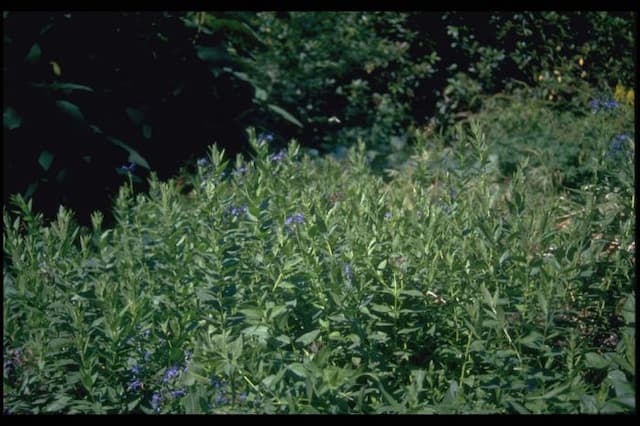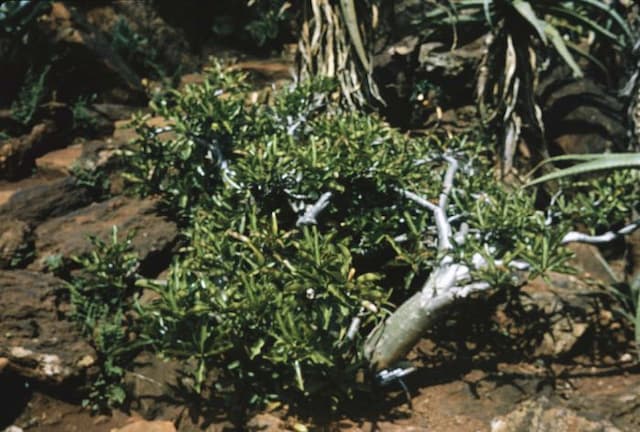Bridal wreath Stephanotis floribunda

ABOUT
S. floribunda is a twining evergreen climber to 5m or more, with leathery, oblong to elliptic leaves and axillary clusters of highly fragrant, slender-tubed white flowers to 5cm in length, with spreading lobes; fruit oblong, green
About this plant
 Names
NamesSynonyms
Madagascar Jasmine, Waxflower, Bridal Wreath, Hawaiian Wedding Flower, Bridal Bouquet.
Common names
Marsdenia floribunda, Sarcostemma floribundum.
 Characteristics
CharacteristicsLife cycle
Perennials
Foliage type
Evergreen
Color of leaves
Dark green
Flower color
White
Height
6 feet (1.8 meters)
Spread
3 feet (0.9 meters)
Plant type
Climber
Hardiness zones
10
Native area
Madagascar
Benefits
 General Benefits
General Benefits- Aesthetic Appeal: Stephanotis floribunda, commonly known as Madagascar jasmine, boasts attractive glossy green leaves and star-shaped, fragrant white flowers, enhancing the beauty of indoor and outdoor spaces.
- Fragrance: Madagascar jasmine's flowers emit a pleasant and strong fragrance that can perfume the surrounding area, creating a relaxing and inviting atmosphere.
- Wedding Decoration: Due to its beautiful and fragrant flowers, Madagascar jasmine is often used in bridal bouquets and as decoration for weddings and other events.
- Gardening Satisfaction: Madagascar jasmine can provide a sense of accomplishment through successful cultivation, as it requires specific care to thrive.
- Habitat for Wildlife: When planted outdoors, the flowers of Madagascar jasmine can attract pollinators such as bees and butterflies, contributing to the health of the local ecosystem.
- Versatility: Madagascar jasmine can be grown as a houseplant, in a greenhouse, or outdoors in suitable climates, making it a versatile choice for various gardening scenarios.
- Climbing Plant: As a vigorous climber, Madagascar jasmine can be used to cover trellises, arches, and fences, providing greenery and privacy in garden designs.
 Medical Properties
Medical PropertiesThis plant is not used for medical purposes.
 Air-purifying Qualities
Air-purifying QualitiesThis plant is not specifically known for air purifying qualities.
 Other Uses
Other Uses- Stephanotis floribunda, commonly known as Madagascar jasmine, can be used in fragrance extraction for perfumes with its sweet, intense scent being highly valued.
- It can serve as a natural pest repellent in gardens due to its strong fragrance that some pests find unattractive.
- The Madagascar jasmine is often used in bridal bouquets and wedding decorations, symbolizing marital happiness.
- The robust vines of the plant can be trained to create green, living curtains for privacy screening on patios or verandas.
- Its long-lasting and elegant blooms are sought after for use in high-end floral arrangements and table centerpieces.
- The plant can be cultivated for educational purposes, such as teaching botany and illustrating the life cycle of perennial vines.
- The Madagascar jasmine's attractive appearance makes it a popular choice for enhancing workplace environments in office buildings and reception areas.
- It can be used in photography and film as a set decoration to evoke a tropical or exotic ambiance.
- The vines of Madagascar jasmine can be utilized in crafting and hobbyist projects, such as creating living wreaths or topiaries.
- Its generous flowering periods make it suitable for inclusion in butterfly gardens to support nectar-feeding insects.
Interesting Facts
 Feng Shui
Feng ShuiThe Madagascar Jasmine is not used in Feng Shui practice.
 Zodiac Sign Compitability
Zodiac Sign CompitabilityThe Madagascar Jasmine is not used in astrology practice.
 Plant Symbolism
Plant Symbolism- Purity: The pristine white blossoms of Stephanotis, also known as Madagascar jasmine, are often associated with innocence and purity, making them a popular choice for bridal bouquets.
- Eternal Love: The durability and perpetual blossoming nature of Madagascar jasmine's flowers symbolize lasting affection and unchanging love.
- Marital Happiness: Due to its frequent use in wedding ceremonies, Madagascar jasmine has come to represent happiness in marriage.
- Good Fortune: The lush, vibrant growth of the plant suggests prosperity and is believed to bring good luck to the home.
 Water
WaterThe Madagascar jasmine requires consistent moisture, so water it once the top inch of soil feels dry, which usually equates to watering once or twice a week. The amount needed can vary with environmental conditions, but generally, it requires about 16 ounces per watering for a standard pot. During the growing season, in spring and summer, water more frequently to maintain soil moisture. In winter, reduce watering slightly, allowing the soil to dry out a bit more between waterings, but never let it become completely dry.
 Light
LightMadagascar jasmine thrives in bright, indirect light. It prefers a spot where it can receive several hours of sunlight but protected from harsh midday sun. An east- or west-facing window where the light is filtered through a translucent curtain is ideal. Avoid placing it in direct, hot sunlight which can scorch the leaves.
 Temperature
TemperatureThe Madagascar jasmine fares best in temperatures between 60-85°F. It can survive minimum temperatures down to 50°F, but growth may slow down. To ensure healthy growth, avoid exposing the plant to temperatures below 50°F and above 85°F, as extremes can damage the plant.
 Pruning
PruningPrune Madagascar jasmine to maintain its shape, encourage bushier growth, and remove any dead or yellowing leaves. Pruning is best done in late winter or early spring before new growth starts. Cut back the vines sparingly and make sure to use clean, sharp shears. Pruning can be annual or biannual, depending on the plant's growth rate and desired size.
 Cleaning
CleaningAs needed
 Soil
SoilMadagascar Jasmine requires a well-draining soil mix, rich in organic matter. A blend of two parts peat or coco coir, one part perlite, and one part pine bark is ideal. The pH should range between 6.5 and 7.5.
 Repotting
RepottingMadagascar Jasmine should be repotted approximately every 2 to 3 years. This ensures that the plant has enough room to grow and refreshes the soil, which gets depleted of nutrients over time.
 Humidity & Misting
Humidity & MistingMadagascar Jasmine thrives in high humidity conditions, ideally between 40% to 80%. Maintaining adequate humidity is crucial for the health of the plant, particularly during the dry winter months.
 Suitable locations
Suitable locationsIndoor
Provide bright, indirect light and high humidity for indoor Madagascar Jasmine.
Outdoor
Place in partial shade with protection from harsh sun for outdoor Madagascar Jasmine.
Hardiness zone
10-11 USDA
 Life cycle
Life cycleCommonly known as Madagascar jasmine, Stephanotis floribunda begins its life cycle as a seed, which will germinate in warm, moist soil conditions, typically within a few weeks. After sprouting, the seedling grows into a young plant with lush, green foliage, and establishes a root system. As it matures into a woody vine, it requires support to climb, and it is at this stage it will begin developing flower buds. Flowering occurs in the warmer months, often in cycles, producing the plant's characteristic waxy, highly fragrant white blossoms. After pollination, which is often facilitated by moths attracted to the scent at night, the plant may produce seed pods containing seeds for the next generation. Stephanotis floribunda can live for many years, continually growing and producing flowers seasonally with proper care and environmental conditions.
 Propogation
PropogationPropogation time
Early Spring
The Madagascar jasmine, known botanically as Stephanotis floribunda, can be propagated most successfully through stem cuttings, ideally in the spring or early summer when the plant is actively growing. To propagate this way, a gardener should cut a healthy, non-flowering stem of about 4 to 6 inches (10 to 15 centimeters) in length, ensuring that there are several leaves on the cutting. The bottom leaves should be removed, and the cut end of the stem should be dipped in a rooting hormone for best results. The stem cutting should then be planted in a mix of half peat and half perlite or sand, providing good drainage and air circulation. It's important to maintain a humid environment for the cutting, often achieved by covering the pot with a plastic bag or dome, and to keep it in bright, indirect sunlight until roots develop, which typically takes several weeks. Ensuring that the cutting does not sit in waterlogged soil is crucial to prevent rot. Once rooted, the new Madagascar jasmine plant can gradually acclimatize to less humid conditions and eventually be moved to a more permanent pot or location.





![Star jasmine [Star of Toscana]](/_next/image?url=https%3A%2F%2Fplants-admin.emdemapps.com%2Fimages%2Fplants%2F%2Fimages%2F604b62fa574d4.png&w=640&q=75)



